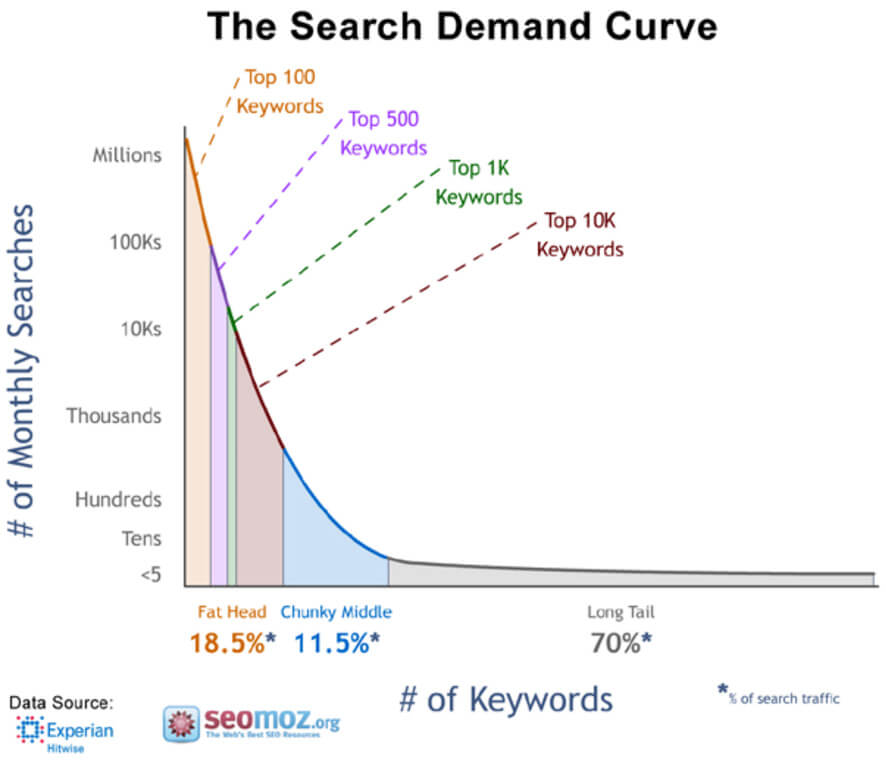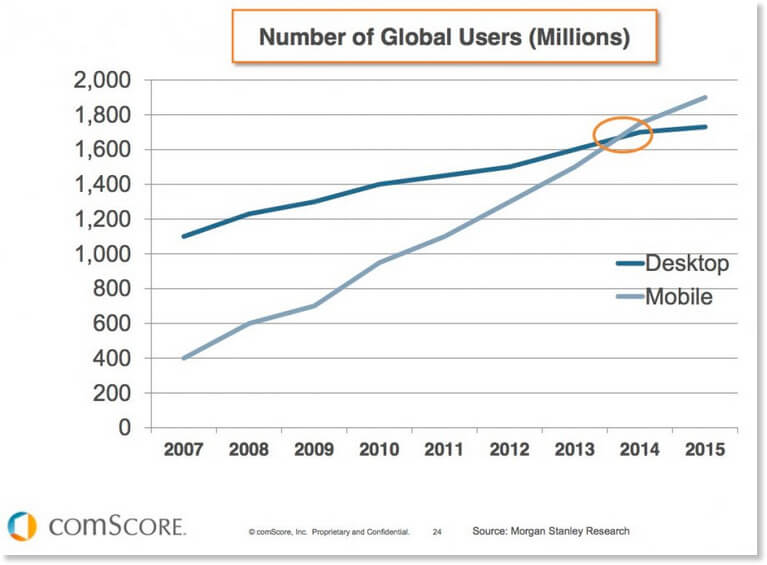10 Common SEO Mistakes That Weaken Your Rankings
Are You Making Any of These SEO Mistakes?
Google processes billions searches every single day.
Ranking for your target keywords can bring in a flood of targeted traffic to your landing pages. But the reality is that your website must be ranking in the top results. Case studies have shown that the top three results get 61% of all search clicks. And a large majority of users rarely click past the first page.
If your pages are not ranking, it could be because your site is not properly optimised for search.
Start by ensuring that you are not making any of the following SEO mistakes. These are the most common ones that we see business owners make all the time. Mistakes from keyword stuffing to building links too fast can all negatively affect your ability to rank.
1. Keyword Stuffing
It used to be that any website could rank just by simply including keywords in the right places. But many webmasters took this took far and began keyword stuffing their content to the point that it was barely readable by visitors. Here is an example of how this looks:

Google strives to deliver the most relevant results. So to combat the rise in
content spam, Google began rolling out the Panda update. Many sites that had keyword stuffed content like the example above had their rankings obliterated.
Go through each of your pages again and look for any instances of keyword stuffing. Then either remove those pages or have them completely rewritten from scratch.
2. Duplicate Title Tags and Descriptions
Another damaging mistake is having the same title tags and meta descriptions for every page.
Each page should have its own unique title and not only for SEO purposes. A descriptive title is far more likely to attract clicks than simply having the company name as the title. Your titles are also visible whenever someone shares your content on their favourite social media platform.
Example titles for an agency that specialises in web design include:
- WordPress Customisation Services | Excellent Design Studio
- eCommerce Template Design | Excellent Design Studio
- Responsive Mobile Design | Excellent Design Studio
Each page has a descriptive title with target keywords. Make sure each title is as unique as possible and remember to keep it under 70 characters as anything longer will be truncated.
Meta descriptions are the snippet of text that you see in the search results under the title. Just like the title tags, make each description unique and engaging to increase click throughs. Keep the description between 150 to 160 characters and remember to include your target keywords.
3. Targeting Keywords That Are Too Broad
Another common mistake that business owners make is targeting keywords that are too broad.
For example, if you offer web design services then you would likely want to rank for “web design”. The problem is that this keyword is too broad. You do not know the intention of the search as the user could simply be doing research. A better option is to target long tail keywords which actually make up a majority of online searches.
These types of keywords are not only more likely to convert but they are also less competitive. A keyword like “mobile web design services in Perth” may not bring in as much as traffic as “web design” but it will convert better and be easier to rank for.
Use Google’s Keyword Planner tool to identify potential long tail keywords you can target.
4. Ignoring Local SEO
Are your customers primarily local?
Then your pages need to be optimised for local keywords.
A survey from Google shows that 4 out 5 consumers use search engines to find local information such as business addresses, operating hours, and phone numbers. Your target audience is likely searching for keywords right now that are relevant to the products and services you offer. Append the city name to your main target keywords (e.g. SEO Marketing Services Perth) in the following areas:
- Title tags
- Meta descriptions
- Headers
- ALT Text
- Copy
It is also a good idea to submit your site to Google My Business as well as other locally based sites to increase visibility on Search, Maps, and Google+. Keeping a consistent NAP format (Name, Address, and Phone Number) gives your site more local SEO benefit.
5. Using Poorly Written Content
“Content is king.”
It’s a familiar saying in the online marketing circles.
But it’s not always true.
Google looks for quality and relevance above all else. If your site is lacking in either of these, your pages stand little chance of ranking. In fact, another mistake webmasters make is assuming that simply having articles on their site will be enough to help their pages.
Many business owners end up hiring low paid writers to churn out article after article. But their rankings are still stagnant and even end up going the opposite direction.
Why?
Because the content is not optimised and fails to deliver any value. The pages that are ranking on the first page of Google for many competitive keywords are there for a reason. The content is top notch and not simply duplicated or rehashed from other sources.
If you want your pages to rank, write the content yourself or hire better writers. Remember to always focus on quality and relevance as low quality content can actually get your site penalised in the search results.
6. Building Links Too Fast
Links continue to be a major ranking factor.
All other factors being equal, a site with more links will almost always outrank a site without any links. Each link is essentially seen as a vote but Google looks at the quality and relevance for each one. Your pages stand little chance of ranking if most links are from spammy sources such as link networks or irrelevant directories.
Another factor that Google looks at is how natural your link profile looks.
Link velocity refers to how many links a page acquires over a period of time. When news publications break a major story, that page can expect to attract hundreds even thousands of links in a matter of hours. But it looks rather suspicious for a newly registered site to acquire that many links.
Which is yet another common SEO mistake.
A new site that attracts thousands of links overnight is often an indication of spam and Google treats it as such. Instead focus on acquiring links that are relevant to your industry and from authoritative sources.
7. Not Following Google’s Quality Guidelines
Google states the following on its Quality Guidelines page:
We strongly encourage you to pay very close attention to the Quality Guidelines below, which outline some of the illicit practices that may lead to a site being removed entirely from the Google index or otherwise affected by an algorithmic or manual spam action. If a site has been affected by a spam action, it may no longer show up in results on Google.com or on any of Google’s partner sites.
Engaging in any of the following is more than likely to result in a ranking penalty:
- Participating in link schemes
- Using hidden text
- Scraping content
- Creating pages with little value
- Creating pages with malicious behaviour
- Using sneaky redirects
Too often we see business owners using questionable tactics to improve their search engine rankings. But these often lead to penalties and even complete removal of their site in Google. Carefully read through the Quality Guidelines and fix any potentially problematic issues.
8. Not Optimising For Mobile Devices
Another common mistake business owners make is not placing enough emphasis on mobile.
Mobile simply cannot be ignored as usage continues to see explosive growth.
Google has even made mobile-friendliness a ranking factor. What this means is that your pages could rank lower in the mobile search results if it is not optimised for mobile devices.
Mobile is also important for another reason: conversions.
Nothing is more frustrating than landing on a page that is not mobile-friendly. The text is too small and you have to constantly pinch in and out to find the information you are looking for. Most visitors will simply exit the page and click through to a competing site. To increase conversions and reduce bounce rates, your site needs to be mobile friendly.
9. Having a Slow Loading Website
Three seconds.
That’s how long visitors expect websites to load.
Any longer and visitors will click out.
The importance of loading times cannot be stressed enough. The reality is that visitors simply do not have the patience to wait for a website to load especially on the go. If your pages are taking longer than a few seconds to load, you could be losing sales.
Use the PageSpeed Insights tool to get a rating of how fast your site is on mobile and desktop along with suggestions to improve loading times.

Each second counts.
So take steps to improve loading times and you can expect conversions to increase as well.
10. Not Keeping Up to Date on Algorithm Changes
Even if your site ranks on the first page there is no guarantee it will stay there.
The ranking algorithms are constantly being updated. In fact, it is estimated that Google updates its algorithm hundreds of times a year. Major updates are also released (e.g. Panda, Penguin, etc.) that have major effects on the search results. The most recent was the mobile update that makes mobile-friendliness a ranking factor.
This is why business owners need to stay updated on the latest algorithm changes. Because rankings could start slipping if you fail to make appropriate changes.
